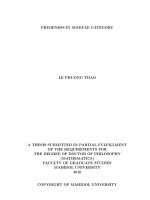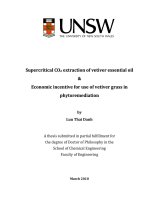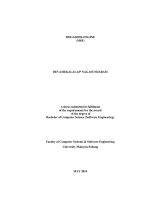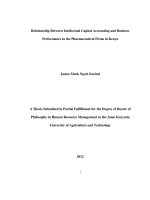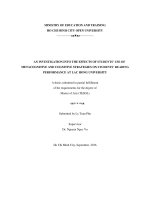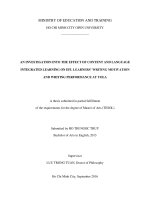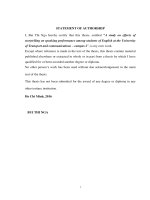A study into EFL learner motivation a thesis submitted in partial fulfillment of the requirements for the degree of master of arts in TESOL
Bạn đang xem bản rút gọn của tài liệu. Xem và tải ngay bản đầy đủ của tài liệu tại đây (1.42 MB, 164 trang )
MINISTRY OF EDUCATION AND TRAINING
HO CHI MINH CITY OPEN UNIVERSITY
A Study into EFL Learner Motivation
THE THESIS SUMMITED IN PARTIAL FULFILLMENT OF THE
REQUIREMENTS FOR THE DEGREE OF MASTER OF ARTS (TESOL)
Submitted by TRAN THI THUY HANG
Supervisor
Assoc. Prof. Dr. NGUYEN THANH TUNG
SEPTEMBER 2016
STATEMENT OF AUTHORSHIP
I certify that this thesis entitled “A Study into EFL Learner Motivation” is my own work.
Except for the reference which is made in the text of the thesis, this thesis contains no
material published elsewhere or extracted in whole or in part from a thesis by which I
qualified for or awarded another degree or diploma.
No other person’s work has been used without due acknowledgement in the main text of
the thesis.
This thesis has not been submitted for the award of any degree or diploma in any other
tertiary institution.
Ho Chi Minh City, 12 September 2016
Tran Thi Thuy Hang
i
ACKNOWLEDGEMENTS
First of all, I would like to express my deepest gratitude to my supervisor, Assoc. Prof.
Dr. Nguyen Thanh Tung, for his generous assistance and great devotion to guiding me
through the preparation and completion of this thesis. Without his great help, I would
have never been able to finish this thesis.
Secondly, I am sincerely grateful to all lecturers of the TESOL program at Ho Chi Minh
Open University for their helpful instruction and dedication from 2012 to 2014.
Thirdly, I want to express my thanks to all the students and English teachers at Ho Chi
Minh University of Technology for their participation in this study.
Finally, I am deeply indebted to my beloved family and my friends for their support and
encouragement so that I could have motivation to complete this thesis.
ii
ABSTRACT
The research was designed to investigate learner motivation at Ho Chi Minh University
of Technology in terms of the reasons why the students learnt English as these reasons
could reveal their motivation types and the factors affecting their learning motivation.
This study also aimed at determining the lecturers’ perceptions toward their students’
motivation.
It has been said that the low English performance of the students in Ho Chi Minh (HCM)
University of Technology has not received enough attention from any studies. Therefore,
the researcher conducted the research with 275 students and their twelve lecturers in
twelve classes in the lowest English level course which requires the most motivational
support. All the students and the lecturers were asked to answer the questionnaires
specially written for them. Furthermore, twelve students chosen randomly and the
lecturers participated in the one-by-one interviews with the researcher. The results
gathered from these questionnaires and interviews were analyzed with the support of
SPSS.
The results from the survey with 275 students indicate that the students are both
extrinsically and intrinsically motivated to learn English. However, their extrinsic
motivation is the dominant because of the better job opportunity in the future and the
usefulness for effective communication in the modern society. The findings also show
that both internal factors and external factors play an important role in enhancing learner
motivation and performance. Among those factors, the English teachers are considered as
a crucial element because they can help the students to follow their learning goals, create
a friendly classroom environment, give supportive feedback, conduct interesting
classroom activities, and design the most suitable materials for their particular classes.
In conclusion, although the lecturers could understand their students’ learning motivation
types and applied varied methods to motivate the students to learn English in class, they
also need more activities to increase the students’ time of using English outside the
iii
classrooms and more support from the administrative staff at the university. Based on the
research findings, some pedagogical implications for the students, the lecturers and the
administrative staff were withdrawn. Hopefully, the results from this research can be
helpful to improve learner motivation in particular as well as the quality of teaching and
learning process at HCM University of Technology.
iv
TABLE OF CONTENTS
STATEMENT OF AUTHORSHIP.................................................................................. I
ACKNOWLEDGEMENTS ............................................................................................. II
ABSTRACT .................................................................................................................... III
TABLE OF CONTENTS ................................................................................................. V
LIST OF TABLES ...........................................................................................................IX
LIST OF ABBREVIATIONS .......................................................................................... X
CHAPTER 1: INTRODUCTION .................................................................................... 1
1.1. Background of the study ............................................................................................ 1
1.1.1. English in Vietnamese tertiary level ...................................................................... 1
1.1.2. Main constraints in Vietnamese learner motivation .............................................. 2
1.1.2.1. Vietnamese learning style ................................................................................ 2
1.1.2.2. Teachers’ action and perception ...................................................................... 3
1.1.2.3. Classroom organization ................................................................................... 4
1.2. Statement of the problem ........................................................................................... 5
1.3. Purpose of the study and the research questions ..................................................... 6
1.4. The significance of the study ..................................................................................... 6
1.5. Limitations of the study ............................................................................................. 7
1.6. The organization of the study .................................................................................... 7
CHAPTER 2: LITERATURE REVIEW ........................................................................ 8
2.1. Definitions of learner motivation .............................................................................. 8
2.2. The importance of learner motivation ...................................................................... 8
2.3. Learner motivation types ........................................................................................... 9
v
2.3.1. Integrative and instrumental motivation .............................................................. 10
2.3.2. Intrinsic and extrinsic motivation ........................................................................ 11
2.4. Research framework ................................................................................................ 13
2.5. Motivation factors..................................................................................................... 14
2.5.1. Internal factors ..................................................................................................... 14
2.5.1.1. Goal setting .................................................................................................... 15
2.5.1.2. Expectancy ..................................................................................................... 15
2.5.1.3. Self-confidence .............................................................................................. 16
2.5.1.4. Self-efficacy ................................................................................................... 17
2.5.2. External factors .................................................................................................... 17
2.5.2.1. Teachers ......................................................................................................... 18
2.5.2.2. Feedback ........................................................................................................ 18
2.5.2.3. Classroom environment ................................................................................. 19
2.5.2.4. Materials ........................................................................................................ 20
2.5.2.5. Activities ........................................................................................................ 20
2.6. Teachers’ perceptions toward students’ motivation ............................................. 21
2.7. Related studies on learner motivation .................................................................... 21
2.7.1. Around the world ................................................................................................. 22
2.7.2. In Vietnam ............................................................................................................ 24
2.8. Research gap ............................................................................................................. 27
2.9. Summary ................................................................................................................... 27
CHAPTER 3: METHODOLOGY ................................................................................. 29
3.1. Pedagogical setting ................................................................................................... 29
3.2. Research design......................................................................................................... 30
3.2.1. Research subjects ................................................................................................. 30
3.2.1.1. Students .......................................................................................................... 30
3.2.1.2. Teachers ......................................................................................................... 31
3.2.2. Research methods................................................................................................. 31
3.2.3. Research instruments ........................................................................................... 33
3.2.3.1. Questionnaires ............................................................................................... 33
3.2.3.2. Interviews....................................................................................................... 35
vi
3.2.4. Analytical framework........................................................................................... 37
3.3. Data collection procedure ........................................................................................ 39
3.3.1. Administering the questionnaires ......................................................................... 39
3.3.1.1. Questionnaire for students ............................................................................. 39
3.3.1.2. Questionnaire for lecturers ............................................................................ 40
3.3.2. Administering the interviews ............................................................................... 40
3.3.2.1. Interview with students .................................................................................. 40
3.3.2.2. Interview with lecturers ................................................................................. 41
3.3.3. Summary of the data collection procedure .......................................................... 41
3.4. Validity and reliability ............................................................................................. 42
3.5. Summary ................................................................................................................... 45
CHAPTER 4: DATA ANALYSIS AND DISCUSSION .............................................. 46
4.1. Data analysis ............................................................................................................. 46
4.1.1. Students’ questionnaire ........................................................................................ 46
4.1.1.1. Students’ profile ............................................................................................. 46
4.1.1.2. Students’ types of motivation ........................................................................ 50
4.1.1.3. Factors affecting students’ motivation........................................................... 53
4.1.2. Lecturers’ questionnaire ....................................................................................... 60
4.1.2.1. Lecturers’ profile ........................................................................................... 61
4.1.2.2. Lecturers’ perception towards students’ types of motivation ........................ 63
4.1.2.3. Lecturers’ perception towards factors affecting students’ motivation .......... 65
4.1.3. Students’ interviews ............................................................................................. 72
4.1.4. Lecturers’ interviews ............................................................................................ 81
4.2. Discussion of the findings ......................................................................................... 90
4.3. Summary ................................................................................................................... 92
CHAPTER 5: CONCLUSIONS AND RECOMMENDATIONS ............................... 93
5.1. Conclusions................................................................................................................ 93
5.2. Research findings ...................................................................................................... 94
5.2.1. Findings for students ............................................................................................ 95
5.2.2. Finding for lecturers ............................................................................................. 96
vii
5.3. Research implications .............................................................................................. 97
5.3.1. Implications for students ...................................................................................... 98
5.3.2. Implications for lecturers ..................................................................................... 98
5.3.3. Implications for administrative staff .................................................................. 101
5.4. Recommendations for further research ............................................................... 102
REFERENCES .............................................................................................................. 105
APPENDICES ................................................................................................................ 112
Appendix 1...................................................................................................................... 112
Appendix 2A ................................................................................................................... 113
Appendix 2B ................................................................................................................... 115
Appendix 3A ................................................................................................................... 117
Appendix 3B ................................................................................................................... 119
Appendix 4...................................................................................................................... 121
Appendix 5A ................................................................................................................... 122
Appendix 5B ................................................................................................................... 137
viii
LIST OF TABLES
Table 1 The procedure of delivering and collecting data .................................................. 42
Table 2 Students’ information (gender) ............................................................................ 46
Table 3 Students’ information (English in their university entrance exam) ..................... 47
Table 4 Students’ information (mid-term score) ............................................................... 48
Table 5 Students’ information (English learning experience) ........................................... 49
Table 6 Students’ information (using English outside the classroom) .............................. 50
Table 7 Students’ reasons for studying English ................................................................ 51
Table 8 Factors related to the students .............................................................................. 54
Table 9 Factors related to the teachers .............................................................................. 56
Table 10 Other motivational factors .................................................................................. 58
Table 11 Lecturers’ information (gender) ......................................................................... 61
Table 12 Lecturers’ information (academic qualification) ................................................ 61
Table 13 Lecturers’ information (teaching experience) .................................................... 62
Table 14 Lecturers’ perception toward students’ reasons of learning English ................. 63
Table 15 Lecturers’ perception toward motivational factors related to the students ........ 66
Table 16 Lecturers’ perception toward motivational factors related to the teachers ........ 68
Table 17 Lecturers’ perception toward other motivational factors ................................... 70
ix
LIST OF ABBREVIATIONS
MOET: Ministry of Education and Training
EFL: English as Foreign Language
L2: Second Language
HCM: Ho Chi Minh
M: Mean
x
CHAPTER 1: INTRODUCTION
1.1. Background of the study
1.1.1. English in Vietnamese tertiary level
English has become the most important foreign language in Vietnamese educational
system at all levels. However, English is especially emphasized at tertiary level because it
plays a crucial role in the future of the leaners who expect to have a better career and
position in society. These leaners need English not only for graduation requirement but
also for a ticket to an international working environment and higher income.
Nevertheless, the matter of English in Vietnamese universities is complicated and
disappointed.
After completing the 10 credits within the first and second years of study, very
few training branches are allowed to provide further English training for students.
Most universities do not have policies or regulations to encourage their learners to
continue learning a foreign language. (Phan H. T., 2010, p. 5)
Phan’s statement pointed that English education in universities has not effectively
prepared students for the demand of English after their graduation. As the result, the
English proficiency of the majority of university students and graduates are quite
disappointing. They do not appear to be confident with their English (Tran T. T., 2013, p.
139). In an effort to discover the reasons behind that unpromising consequence, Tran
(2013) in her study mentioned learner motivation as a vital factor affected English
learning process in Vietnamese universities. She reported that good motivation can be
viewed as a factor which can positively lead to the successful enhancement of English
teaching and learning at universities (p. 141). In addition, she also had further analysis in
Vietnamese setting:
The teaching of English in Vietnamese universities received many criticisms from
the participants. They all suggested that the current English teaching and learning
1
at universities was ineffective and disappointing. It negated their motivation and
made them lose their hope in English learning. (p. 141)
Therefore, in order to improve the current English achievement in universities, learner
motivation should be the center of attention. The following section turns to focus on
learner motivation.
1.1.2. Main constraints in Vietnamese learner motivation
Despite of the previously mentioned essential influence of learner motivation on English
learning process, it is believed that Vietnamese university students obtain a low level of
motivation. Tran and Richard Jr. (2007) wrote that:
Despite the current extrinsic pressures to learn English as a foreign language in
Vietnam, many students don’t seem ever to have developed any interest in
learning English, or if they have, they seem to have lost that interest for some
reason, that is, they have become demotivated. (p. 81)
Sharing the same point view, Phan and Le (2009) also noted that Vietnamese students are
not strongly or appropriately motivated. As the result, the students turn to lose their
enthusiasm and confidence in English learning (p. 164). That situation has received a
number of studies analyzing the constraints of learner motivation in Vietnamese tertiary
system. As the result, Vietnamese learning style, teachers’ action and perception as well
as classroom organization are viewed as the main constraints. The following section will
discuss Vietnamese learning style.
1.1.2.1. Vietnamese learning style
The first constraint refers to Vietnamese passive learning style. The Confucianism even
now maintains its influence on preventing leaners from interrupting their teachers with
questions (O'Sullivan, 1997, p. 51). Moreover, Le (1999, p. 4) noted that “influenced by
Confucianism, students feel rude if they interrupt, question, or argue with their teacher”.
In other words, raising learners’ voice in class is discouraged because of ethic boundaries
in society. Therefore, Vietnamese students tend to be passive in classrooms and depend
2
on their educators. Nguyen (1989) and Tran (1999) reported that: “The attempt to have
insight into Vietnamese students’ voices remains limited owing to the commonly held
belief that teachers are traditionally considered the knowledgeable “expert”. Ly (2007, p.
153) also contributed: “students may think that it is more beneficial to let teachers decide
their needs, because teachers know more about what they need to learn and how their
knowledge will be assessed in examinations”. Dang (2010, p. 6) continued the argument
with his point that Vietnamese students are accustomed to getting the knowledge from
their teachers. Learning actively is not a common habit of Vietnamese students (Le S. T.,
2011, p. 38). Accordingly, Vietnamese learners gradually lose their own interest in
classrooms and the ability to set their goals in learning English. This situation results in
the fact that Vietnamese student motivation has been decreasing considerately, which
triggers their low English proficiency. The next section will discuss the teachers’ action
and perception.
1.1.2.2. Teachers’ action and perception
Besides Vietnamese learning style in the last section, the second constraint, Vietnamese
teachers’ action and perception, also has an important effect on learner motivation.
“Teachers were found to have a strong impact on students’ demotivation or motivation to
learn” (Tran & Baldauf, 2007, p. 100). However, the influence of Vietnamese university
educators is believed to be negative. Luu (2011) raised his convincing points:
The word “ignore” is highlighted since numerous teachers understand the position
of the learner element in their teaching strategies. Nevertheless, they do not want
to explore it due to such factors as time constraints, energy insufficiency (due to
teaching several hours a day), brief and unrepeated teaching of a particular class,
and pride in their degrees or ranks. It is their “pride” that a number of teachers
even take students’ resistance as an offence, but teaching students without
understanding them is a greater offence like doctors treating patients without
investigating their medical histories. (p. 285)
3
Based on Luu’s opinion, the reasons why Vietnamese lecturers have remained traditional
demotivating teaching style have been certainly clarified. However, another important
cause is discovered in teachers’ perception. Tomlinson and Bao Dat (2004) found that
“teachers believe their students to be passive, not willing to participate in classroom
activities, and seldom speaking English in the classroom. For these reasons, they keep on
using a lecturing style in class” (p. 38). Holding that unsupportive viewpoint, teachers are
unable to motivate themselves and their students to create a successful English teaching
and learning process. Furthermore, some special circumstances at a tertiary level have
exacerbated the problem. Tran (2013) wrote about university teachers as follows:
Despite knowing different modern language teaching methods (at least by names),
they normally did not bother to use these methods. This was because (1) no one
‘forced’ them to use these methods, (2) it was too hard to make use of the new
methods given the current situation of class size, limited resources and the need to
provide enough for-the-exam-knowledge to students and (3) renovate teaching
style required time and efforts, but no incentives were given for the teachers who
spend their time to make use of new teaching methods. (p. 142)
Thus, the negative influence of teachers’ action and perception must be recognized as a
serious constraint against learner motivation. Moreover, classroom organization will be
mentioned in the next part.
1.1.2.3. Classroom organization
In addition to learning style, teachers’ action and their perception, classroom organization
is also justified for its significance. The first aspect to mention would be overcrowded
classrooms. Classrooms of one lecturer with more than 40-50 students tend to encourage
traditional passive learning and teaching process. Nevertheless, the difference in students’
English level, the second aspect, is central to low learning motivation. “In most
universities, students who have already learnt three or seven years of English at school
are still placed in a class with the students who had not learnt any English before entering
4
university”, which leads to the fact that “students who had to relearn English felt bored,
while the others felt nervous and lacked confidence” (Tran T. T., 2013, p. 141).
Consequently, not only students with a low English level but also those with a high one
find English classroom unexciting to participate in. This issue shows that the gap in
English proficiency among university students contributes to the decrease in learner
motivation and the quality of English teaching and learning at universities.
In short, Vietnamese learning style, teachers’ action and their perception together with
classroom organization have created a number of difficulties for leaner motivation in
supporting English competence at a tertiary level. Furthermore, the statement of the
problem is presented in the next part.
1.2. Statement of the problem
English has become the predominant foreign language in Vietnam. Therefore, English
educational system at all levels has received the most attention from the government and
society. However, the outcome of English teaching and learning process at a tertiary level
could not satisfy the social expectation. In an attempt to find out the possible reasons for
that issue, learner motivation with its powerful influence on English learning is
emphasized. Despite Vietnamese learning style, teacher’s action and perception and
classroom organization as main constraints, learner motivation is believed to be the factor
supporting English learning practice at universities. Nguyen (2012, p. 73) emphasizes
that if Vietnamese students get proper encouragement, they can become motivated and
eager to follow English learning process. However, “teachers’ lack of knowledge about
their students’ real reasons for learning a language is one of conditions that impede our
full understanding of students’ motivation for L2 learning (Oxford & Shearin, 1994, as
cited in Zhao, 2012, p. 100). That point raised the significant concern over teachers’
understanding of learner motivation. Consequently, leaner motivation at universities in
Vietnam needs to be further investigated for higher understanding and encouragement.
Therefore, the purpose of the study is presented in the next part.
5
1.3. Purpose of the study and the research questions
Based on the findings of the previous studies, this research is an attempt to (i) investigate
what motivation types the students at HCM University of Technology have, (ii) discover
the most supporting motivation factors for these students, and (iii) explore their teachers’
perception of learner motivation. To achieve the aims set up above, the study is
conducted with an effort to find out the answers to the following research questions:
1. What kind of learner motivation do the students at HCM University of Technology
hold?
2. What are the most important factors influencing learner motivation at HCM
University of Technology?
3. How do the teachers at HCM University of Technology perceive their students’
motivation?
1.4. The significance of the study
Motivation plays an important role in English learning because it can contribute to the
success of learning process. The findings of this paper hopefully could inform teachers of
their leaners’ motivation types and motivational factors affecting their learning
achievements. Therefore, the English learning and teaching at HCM University of
Technology can develop, as once the students are motivated, their English results can be
improved. Furthermore, the research findings can help the school administration deeply
understand the effects of learning environmental factors on the students’ outcomes in
order that they can provide the students with more teaching facilities as well as better
learning conditions. Moreover, the study also suggests some practical implications for
better motivation support in their classrooms at HCM University of Technology or other
universities sharing common features.
6
1.5. Limitations of the study
The study only deals with the first year students in the first level (English 1 according to
the internal program) of HCM University of Technology. Therefore, it mostly aims to be
applied in this university, not to be generalized to other universities. Furthermore, the
study does not cover all motivation factors because of the time limit.
1.6. The organization of the study
The study includes five chapters.
Chapter 1 presents the study background, the reasons why the researcher choses this
topic, the purposes and research questions, as well as the organization and limitations of
the study.
Chapter 2 reviews relevant theories on learner motivation definition, types of learner
motivation and the factors affecting learner motivation.
Chapter 3 describes the design and methodology in which the study is carried out. It
involves research method, research design, population and sample, instruments, data
collection procedure and method of analysis.
Chapter 4 presents the data analysis and discussion of the findings.
Chapter 5 summarizes the study and offers some limitations of the study, implications
and recommendations for further research.
7
CHAPTER 2: LITERATURE REVIEW
2.1. Definitions of learner motivation
Because of the essential influence of learner motivation, there are a considerable number
of studies discussing its definition and types. According to Oxford and Shearin (1994, p.
12), learner motivation has been viewed as an important encouragement to start and
maintain a long term language learning process. Therefore, many authors conducted
numerous studies on motivation and provided their definitions of learner motivation.
Thus, “it is not possible to give a simple definition” for leaner motivation (Gardner, 2006,
p. 242). The researchers supporting behaviourism defined motivation as “the anticipation
of reward" (Brown, 2000, p. 160). Nevertheless, the cognitivists shared the opinion that
students’ decisions should have been mentioned when discussing leaner motivation
because of "the choices people make as to what experiences or goals they will approach
or avoid, and the degree of effort they exert in that respect" (Keller, 1983, p. 389).
However, Al-Tamimi and Shuib (2009, p. 31) claimed the constructivists also focus on
social contexts on the way searching the definition for leaner motivation. In short, learner
motivation can be defined as "the fulfillment of needs” and it “is rewarding, requires
choices, and in many cases must be interpreted in a social context” (Brown, 2000, p.
161). That can be the explanation for the fact that “even though some students might be
naturally enthusiastic about learning, many (of them) need or expect their instructors to
inspire, challenge, and stimulate them” (Ullah & Fatema, 2013, p. 130). Therefore,
learner motivation is defined as a fulfillment of needs in a social context seems to the
most appropriate in the context of the study with the investigation of the tertiary level and
the teachers’ perception toward learner motivation. The next part is written for the
understanding of the importance of learner motivation.
2.2. The importance of learner motivation
The previous part introduced many definitions of learner motivation from many previous
studies. This part focuses on the essential role of learning motivation in language
8
learning. In the long-term development of English learning and teaching, “motivation is
… one of the most important elements in learning. Without motivation, learning is not
likely to take place..., if the learners are not motivated to learn, there will be little
learning” (Nation, 1975, p. 115) .The importance of learner motivation was also
highlighted by McDonough (1983, p. 142) with the statement that learner motivation is
one of the most essential factors deciding the students’ success or failure in English
learning. Moreover, according to Oxford and Shearin (1994, p. 12), learner motivation
should be considered as a primary support to begin and retain language learning in a long
term. In addition, Lifrieri (2005, p. 4) reported that “when asked about the factors which
influence individual levels of success in any activity – such as language learning – most
people would certainly mention motivation among them”. Furthermore, Tran and Baldauf
Jr. (2007, pp. 79-80) in their paper in the case of Vietnamese students summarized that
“motivation is one of the main determining factors in an individual’s success in
developing a second (L2) or foreign language (FL)” because “it directly influences how
much effort students make, (…)how high their general proficiency level becomes, and
how long they preserve and maintain L2 skills after language study is over”.
In short, leaner motivation plays a crucial role in English language learning process.
Consequently, it should be encouraged and enhanced in an attempt to improve students’
English competence in Vietnamese universities. However, there are some constraints
against Vietnamese learner motivation as focused in the next sections. The next part will
introduce some learner motivation types and explain the researcher’s choice of the most
appropriate concepts in this research.
2.3. Learner motivation types
In addition, learner motivation is generally classified into two pairs, integrative
orientation and instrumental orientation (Kang, 2000) or intrinsic and extrinsic
motivation (Deci & Ryan, 1985). The comparison among them is still under formidable
argument with different points of view. This section is going to explain the meanings of
9
those pairs and the researcher’s choice to apply the more suitable pair in the study. The
first pair, integrative and instrumental motivation is discussed in the next part.
2.3.1. Integrative and instrumental motivation
In a social psychological framework, learner motivation was identified based on two
types of orientations: integrative orientation and instrumental orientation (Kang, 2000, p.
2). Benson (1991) suggested that integrative motivation represents an expectation to be
bilingual and even bicultural. In other words, integrative orientation is related to a
positive tendency to the target language group and a desire to be accepted as a member in
that group (Dörnyei, 2001b, p. 49). On the other hand, instrumental orientation describes
reasons for language learning associated with the potential realistic benefits. Norris-Holt
(2001) supplemented that point with further explanation that
“with instrumental
motivation the purpose of language acquisition is more utilitarian, such as meeting the
requirements for school or university graduation, applying for a job, requesting higher
pay based on language ability, reading technical material, translation work, or achieving
higher social status. Instrumental motivation is often characteristic of second language
acquisition, where little or no social integration of the learner into a community using the
target language takes place, or in some instances is even desired” (p. 2). Different
currents of ideas have been introduced to discuss the comparison between integrative and
instrumental motivation. Generally, as Lei Zhao (2012, p. 101) stated, instrumental
orientation is greatly appreciated because it is considered as a stronger effort when
learners become active. That point of view has been supported by a number of studies in
the following years. Norris-Holt (2001, p. 3) was successful in borrowing the ideas from
Taylor, Meynard and Rheault (1977); Ellis (1997); Crookes Schmidt (1991) to suggest
that integrative motivation has played a more important part to maintain a long-term
learning process. However, a study carried out by Lukmani (1972) reported an opposite
fact that instrumental motivation predominated in the second language learning process
of the Indian female learners. Dörnyei (1990) also found that under-intermediate learners
tend to get higher improvement by the force of instrumental motivation than by one of
10
integrative motivation. However, in higher level of language proficiency, learners must
possess integrative motivation to really learn the language and get further achievement. It
means that instrumental motivation should be stressed as an essential factor affecting
language learners’ performance while integrative motivation is stressed as an
indispensible condition for overall higher success in second language acquisition.
Therefore, Brown (2000) shared the view that both integrative motivation and
instrumental motivation are important in language learning. In his study, the finding
showed that the international students living in America were learning English for
academic purposes and social integration. It led to the conclusion that integrative and
instrumental motivation should not be exclusively separated because students generally
employ the combination of them in their learning. However, there is also another pair of
motivation, intrinsic and extrinsic motivation researched in many studies about language
learning, which will be discussed in the next part.
2.3.2. Intrinsic and extrinsic motivation
In self-determination theory, Deci and Ryan (1985) classified motivation into intrinsic
and extrinsic motivation according to the reasons or goals of the learners.
Csikszentmihalyi and Nakamura (1989) provide the definition that motivation is intrinsic
when the reasons for participating to the activities start from the enjoyment the activities
possess, and that motivation is extrinsic when these reasons come from outside of the
activities themselves. Their concepts were repeated in Ryan and Deci’s (2000, p. 55)
study with the statement that intrinsic motivation is connected to performing in an
activity because it is interesting itself while extrinsic motivation refers to the performance
resulting from separated outcomes like prizes, money, job promotion, grade, or positive
feedback, etc. Another study later also shared the similar definition that learners are
intrinsically motivated by the pleasure and interest within the activities and extrinsically
motivated by the consequence apart from the pleasure and interest within the activities
(Noels, 2001, pp. 45-46). In the comparison between intrinsic and extrinsic motivation,
Brown (1994) believed that intrinsic motivation is more powerful in encouraging students
11
to pursue their language learning career. This view is supported by Ushioda (1996) who
wrote that learners “may work efficiently in the short term in response to external
rewards and incentives, but their motivation is unlikely to sustain itself autonomously if
the learning experience does not generate internal or intrinsic rewards” (p. 22). His point
is sensible because solitary extrinsic motivation could turn learners to become passive
because the disappearance of extrinsic rewards can discourage them from persisting
studying. However, both intrinsic and extrinsic motivation are essential in language
learning process as Pan, Zang and Wu (2010, p. 154) said “the intrinsic motivation is
sometimes thought to relate to long-term success. Extrinsic motivation is thought more
related to short-term success.”
Under the discussion of the relationship among integrative, instrumental, intrinsic and
extrinsic motivation, Lei Zhao (2012, p. 110) offered a significant explanation:
The intrinsic and extrinsic motivation provide us another perspective to understand
the source of motivation. This model is not meant to replace the integrativeinstrumental distinction, but rather to complement it (Oxford, 1996). According to
Kang (2000), foreign language learning orientations, in settings where most
learning of English takes place in the formal classroom, might consist of subcomponents of Gardner’s traditional integrative/instrumental orientations as well as
intrinsic/ extrinsic orientations, depending on the contexts.
Based on that view, it is possible to say that the two pairs of motivation constructs are
important but the model of intrinsic and extrinsic motivation seems to more sufficient for
the detailed investigation of leaner motivation at HCM university of Technology where
English is learnt as a foreign language in formal classrooms. Therefore, the researcher
attempts to employ two concepts, intrinsic motivation and extrinsic motivation, to
investigate the types of learner motivation in this study. Besides the types of learner
motivation, the motivation factors also get great attention from many researchers because
they are the direct elements affecting learners’ motivation and performance. The
12
following section will discuss a framework listing the most important factors in the
research on learner motivation in English learning.
2.4. Research framework
From many previous studies on learner motivation, the researcher found the framework
of learner motivation designed by Williams and Burden (1997) the clearest one in
contents and presentation (See Appendix 1). This framework was also employed by Zhao
(2012) in his research, “Investigation into motivation types and influences on motivation:
The case of Chinese non-English majors”. The framework listed all the motivational
factors which were divided into two groups consisting of the internal factors and the
external factors.
The first group includes intrinsic interest of activity, perceived value of activity, sense of
agency, mastery, self-concept, attitudes, developmental age and stage, gender, and other
affective states. For more details, the arousal of curiosity and optimal degree of challenge
are mentioned in the intrinsic interest of activity while personal relevance, anticipated
value of outcomes and intrinsic value attributed to the activity explain the perceived
value of activity. Furthermore, the sense of agency includes locus of causality, locus of
control process and outcomes as well as the ability to set appropriate goals. In addition,
mastery focuses on feeling of competence, awareness of developing skills and mastery in
a chosen area and self-efficacy. Besides, self-concept aims at personal realistic
awareness, strengths and weaknesses in skills required, personal definition, judgments of
success and failure together with self-worth concern learned helplessness. Moreover, the
attitudes toward language learning in general mean the attitudes to the target language
and to the target language community and culture. Confidence, anxiety and fear are also
mentioned as other affective states.
The second group of the factors is external factors which consist of significant others, the
nature of interaction with significant others, the learning environment and broader
context. The significant others are the people who can strongly affect the students’
13
learning performance, such as their parents, their teachers or peers. The nature of the
interaction between them and the students are explained by the mediated learning
experience, the feedback, rewards or punishments. Furthermore, the comfort, resources,
time, and size of the classrooms are highlighted in the learning environment. The broader
context consists of wider family networks, the local education system, conflicting
interests, cultural norms, and societal expectations and attitudes. In short, there are many
factors which can influence English learning motivation. However, this research is only
capable of concentrating on some most outstanding elements which received the most
attention in other previous studies due to the limit of time, the maximum length of the
paper and the available resources. Those elements are present in the next section.
2.5. Motivation factors
Besides motivation classification, “it is important to find out the underlying causes of
students’ motivation in English learning and the possible factors that influence students’
sustaining motivation, especially in a practical sense to teachers who want to stimulate
students’ motivation” (Zhao, 2012, p. 100). Although many frameworks of motivational
factors have been introduced, Williams and Burden’s (1997) model seems to be
comprehensible to investigate in this research study. As leaner motivation is considered
an important condition for acquiring a foreign language, the factors which can increase or
decrease leaner motivation also receive great attention in many frameworks. Williams
and Burden (1997) provided a comprehensive framework including significant internal
and external factors. However, this framework covered too many aspects for a study to
investigate. Therefore, in this study the researcher plans to focus only on some key
factors which have been emphasized in many previous studies. The factors can be
classified into two groups, internal factors and external factors. The first group is
discussed in the next part.
2.5.1. Internal factors
Internal factors refer to learner’s perceptions of themselves and their control in the
activities (Williams & Burden, 1997, p. 137). There are many studies written about the
14


